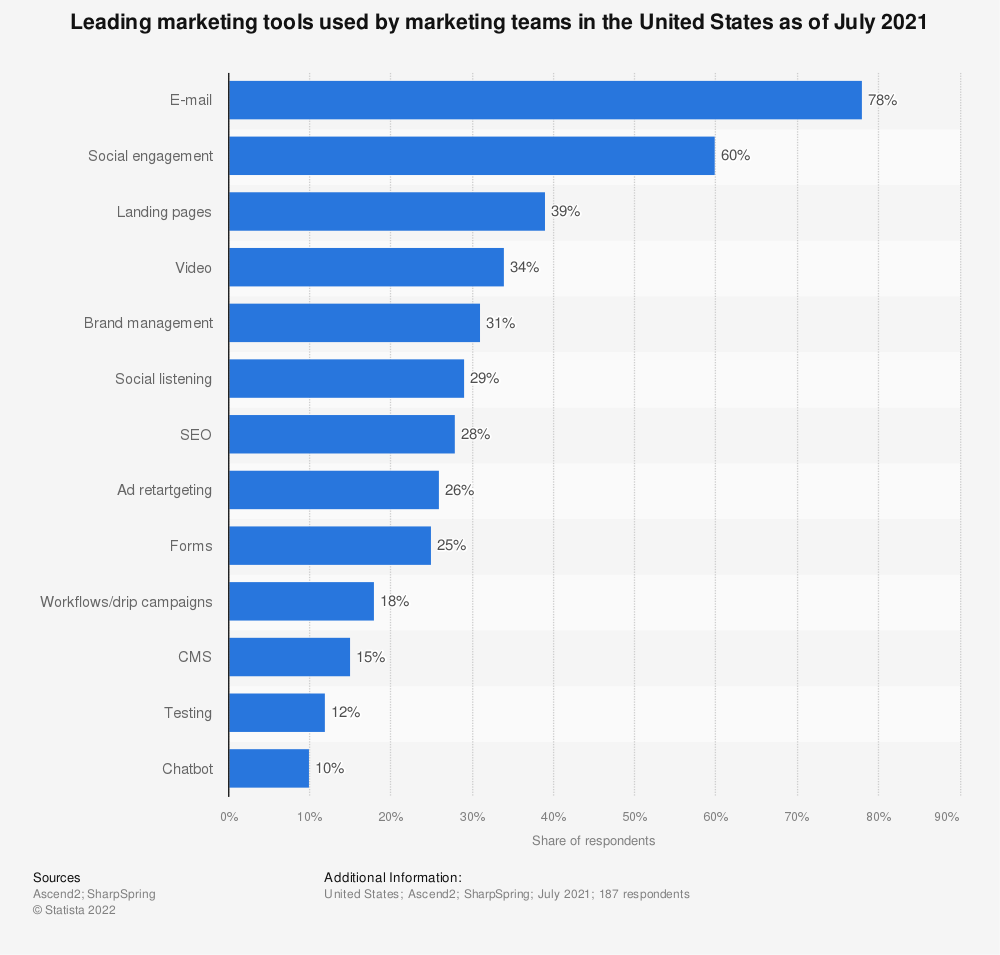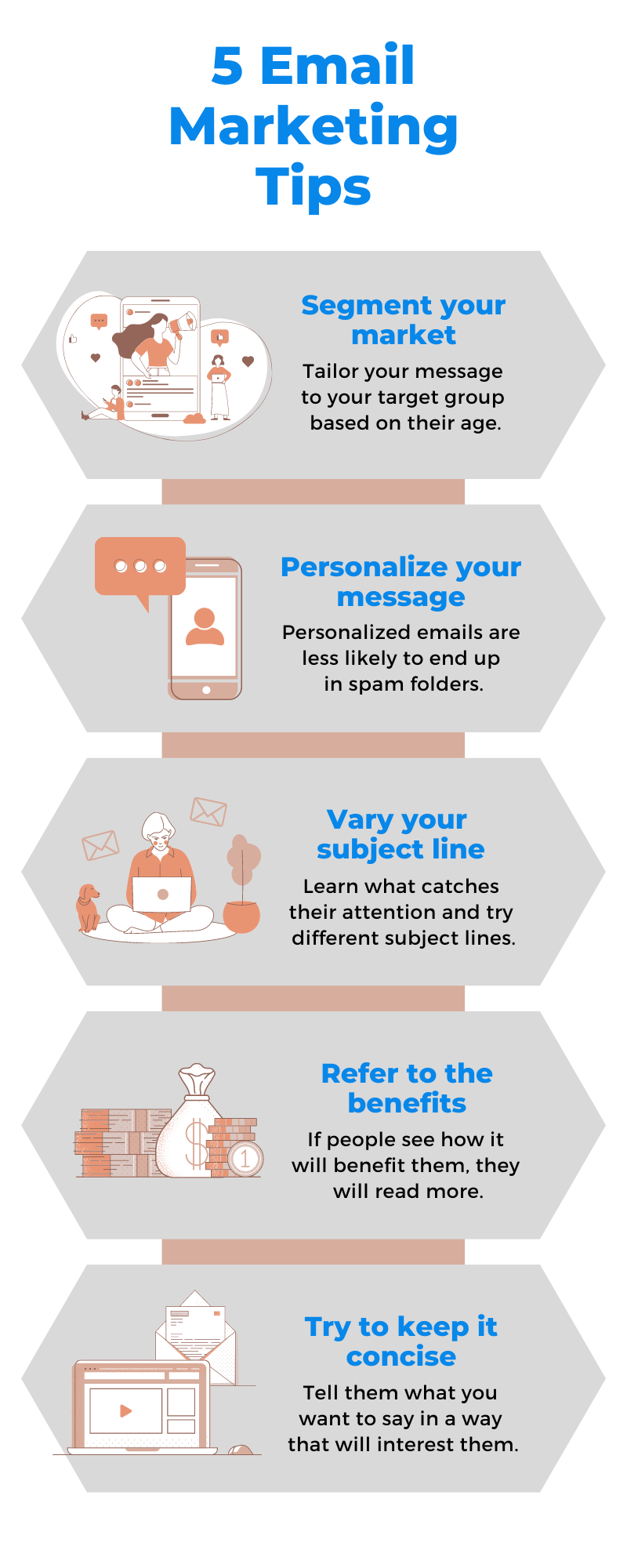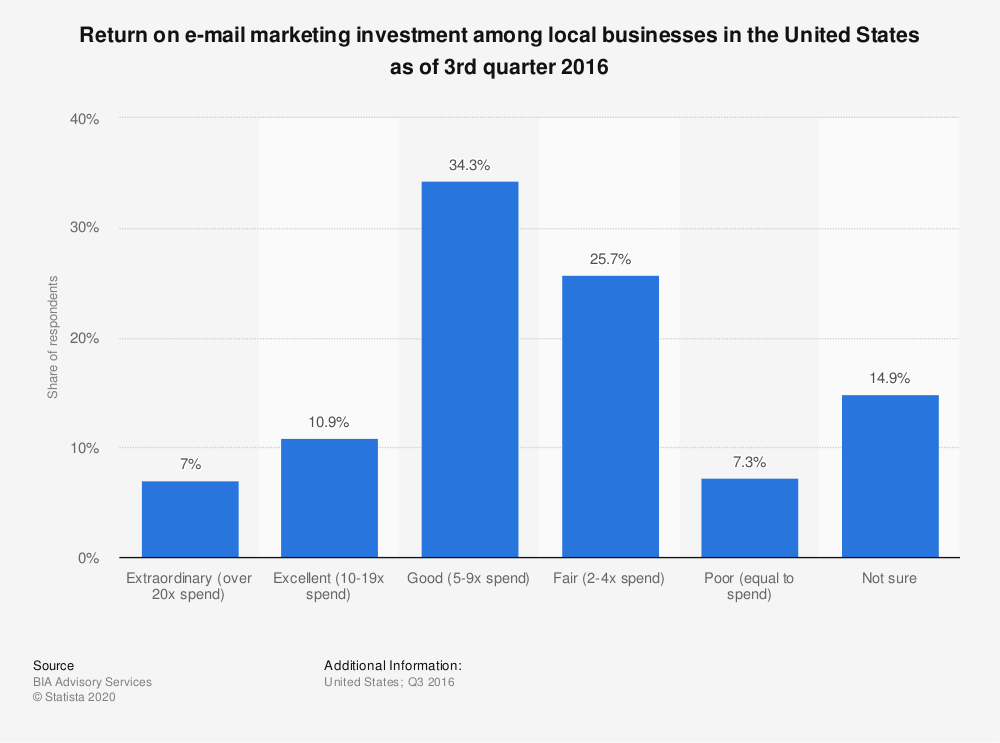Starting a business is hard enough without having to worry about the expense of marketing. But unfortunately, marketing is often one of the most expensive items in a startup’s budget.
The goal for any startup is to get traction and grow the business quickly and efficiently. With that in mind, one of the smartest things a startup can do is focus on email marketing. Email marketing is an inexpensive way to reach a large audience, and it’s an effective way to build relationships with potential customers.
When done correctly, email marketing can be a powerful tool for driving sales and growing a startup. There are a number of reasons why email marketing matters to startups.
- An email is an intimate form of communication. It’s personal and direct, which allows you to connect with your audience in a way that other forms of marketing (such as social media) cannot match.
- Email marketing is fast and easy. One of the biggest challenges of marketing a startup is getting your message out quickly and efficiently. With email marketing, you can create and send messages quickly and easily. You can also track how many people open and click through your emails, so you can gauge the effectiveness of your campaigns.
- Email is an effective way to drive traffic to your website or blog. Every time you send an email, you’re essentially giving your audience a mini-advertisement for your business. If your email is well-written and contains a call-to-action, then you’re likely to see a significant boost in web traffic.
- Email marketing is also extremely cost-effective. Unlike many other marketing channels, there are no upfront costs associated with email marketing. You can reach a large number of people for very little money – making it an ideal solution for startups on a tight budget.
- Email marketing is trackable. Unlike some other channels (such as print or television), you can easily track how successful your email marketing campaigns are. This means you can quickly adjust and improve your campaigns based on real-time data, ensuring that you get the most out of your email marketing efforts.
- Email marketing builds relationships. When you are first starting out, it is important to build relationships with potential customers. Email marketing allows you to stay in touch with your subscribers and develop a rapport over time.

Email marketing is one of the most effective ways to reach your target audience. Unlike other forms of marketing, email allows you to target a specific group of people with laser precision.
But it can be tricky to get started. Here are five tips to help you make the most of your email marketing campaign:
- Segment your market
In email marketing, segmenting your market means dividing your list of subscribers into smaller groups based on shared characteristics. By segmenting your market, you can send more targeted and relevant emails that are better able to convert leads into customers.
There are a number of different ways to segment your market, including by location, age, gender, interests, and more. The most important thing is to choose the right criteria for your business and then use that to create meaningful segments.
Once you’ve segmented your market, you can start creating more targeted and effective email campaigns. With the right approach, segmenting your market can be a powerful tool for growing your business.
- Personalize your message
Personalizing your message in email marketing simply means including the recipient’s name in the email. You can also personalize your message by segmenting your list and tailoring emails to specific subsets of your audience.
For example, you might send different emails to those who haven’t engaged recently than you do to those who have been opening and clicking through your messages regularly.
Personalized messages can also be created based on past interactions someone has had with your brand.
Advantages of personalized email marketing messages can include an increase in open rates, click-through rates, and conversions. When people see their own name in an email subject line, they’re more likely to open it. And when the content of the email is relevant to their interests, they’re more likely to click through and take action.
Ultimately, personalization can lead to more valuable relationships between you and your subscribers.
- Vary your subject line
One important aspect of effective email marketing is to vary your subject line. This means testing different subject lines to see which ones are more likely to get opened and read. There are a few different ways to go about this, but one common method is called A/B testing.
This involves sending out two different versions of an email, each with a different subject line, and then measuring the results to see which version performed better. There are a number of advantages to A/B testing, including the ability to fine-tune your subject lines for maximum impact and the ability to track results over time.
However, it’s important to keep in mind that A/B testing can be time-consuming and may not always produce clear-cut results. Nonetheless, it’s a valuable tool that can help you improve your email marketing campaigns.
- Refer to the benefits
When email marketing, it’s important to always keep the reader in mind. What will interest them? How can you make this email worth their while? One key way to do this is by focusing on the benefits of what you’re offering. Whether it’s a new product, a sale, or simply informative content, make sure to highlight how it will benefit the reader. What problem does it solve? How will it make their life easier?
Answering these questions will help you to craft an email that will keep the reader engaged from beginning to end. So when in doubt, always think about the benefits.
- Try to keep it concise
In email marketing, “keeping it concise” means writing emails that are short and to the point. Although it can be tempting to include lengthy sales pitches or show off your latest product, doing so can actually deter potential customers.
In general, people prefer to read emails that are concise and easy to digest. Emails that are too long or dense can be quickly skimmed or even ignored altogether.
Instead of bombarding subscribers with a novel-worth of information, try to focus on one key message and write in a clear, concise style. You may find that your emails are more effective – and more likely to be read – as a result.

ROI On Email Marketing Among Local Businesses
Any experienced marketing professional will tell you that there is no surefire way to guarantee a return on investment (ROI) from any given marketing campaign.
However, email marketing is one of the most cost-effective and ROI-friendly methods available. By its very nature, email marketing allows you to target a large audience with your message without incurring exorbitant costs.
Many local businesses are wondering if email marketing is worth the investment. To put it simply, the ROI of email marketing depends on a number of factors, including the size of your list, the quality of your content, and the effectiveness of your call to action.
However, one study found that the average ROI for email marketing among local businesses is $38 for every $1 spent. This means that for every dollar you spend on email marketing, you can expect to see an average return of $38.

Email marketing is a powerful tool for local businesses, providing an excellent return on investment. When done well, email marketing can nurture relationships with customers, build loyalty, and generate new sales. So how can you make sure you’re getting the most out of your email marketing campaigns? Here are four tips:
1. Keep your list clean and up-to-date. Remove inactive subscribers and bounced emails on a regular basis. This will help improve your deliverability and ensure that your messages are reaching your target audience.
2. Use segmentation to send targeted messages. By dividing your list into smaller groups, you can send more relevant and personalized messages that are more likely to resonate with each group.
3. Make use of triggered emails. Timing is everything when it comes to email marketing, so take advantage of automated messages that are sent based on subscriber behavior – such as welcome emails, abandoned cart reminders, and post-purchase follow-ups.
4. Always test and optimize your campaigns. A/B testing is essential for email marketing success. Try different subject lines, call-to-actions, images, and layout to see what works best for your audience.
When used correctly, email marketing can be an invaluable asset for any local business.
What Is ROI In Digital Marketing?
In today’s digital world, it’s more important than ever for businesses to have a strong online presence. After all, that’s where most consumers are spending their time.
The term “ROI” stands for “return on investment.” In digital marketing, ROI is a metric that measures the efficiency of a company’s marketing spend. In other words, it tells you how much revenue your company is getting in return for every dollar you’re spending on marketing.
There are a number of ways to measure the success of your digital marketing campaigns. One way is to track the number of leads that you generate. This can be done through website analytics, which will show you how many people visit your site and fill out contact forms or sign up for newsletters.
Another way to measure the success of your digital marketing is to track the number of conversions, or sales. This can be done by setting up goals in Google Analytics, which will track how many people take the desired action on your site after clicking on an ad or landing page.
Finally, you can also measure the ROI of your digital marketing campaigns by tracking the amount of money you spend on campaigns and comparing it to the results that you generate.

Many businesses are looking for ways to improve their return on investment (ROI) from digital marketing. Here are five best practices that can help:
1. Define your target audience and objectives. Without a clear understanding of who you are trying to reach and what you want to achieve, it will be difficult to measure ROI.
2. Develop a data-driven approach. Track everything you can, including website traffic, leads, and sales. This data will be essential in understanding what’s working and what’s not.
3. Experiment and test. Try different strategies, tactics, and channels to see what produces the best results. Be sure to track your results so you can easily identify which changes are having the biggest impact.
4. Make use of automation. Automating repetitive tasks frees up time that can be better spent on other tasks, such as creating new content or engaging with customers.
5. Focus on quality over quantity. It’s better to have a smaller number of high-quality leads than a large number of low-quality ones. Quality leads are more likely to convert into customers, so they’re worth more in the long run.
Whether you’re a small business or a large corporation, if you want to be successful with your digital marketing, you need to measure your ROI.
How Do You Use Email Campaigns To Increase Sales?
email campaigns are a great way to reach out to potential and current customers. However, there are a few things to keep in mind when creating an email campaign. First, it’s important to have a clear email marketing strategy.
What are you trying to accomplish with your email campaign? Who is your target audience? Once you have a good understanding of your goals and who you’re trying to reach, you can start creating your email template. Keep your template simple and easy to read, with a clear call-to-action.
email campaigns are one of the most powerful tools that a marketer has at their disposal. By building an email list and sending targeted messages to this list on a regular basis, businesses can create a database of interested potential customers who can be reached with the click of a button.
Email campaigns can also be used to increase brand awareness and generate new leads, both of which are essential for increasing sales. When planning an email campaign, it is important to keep these goals in mind and design your messages accordingly. With a little creativity and effort, email campaigns can be an extremely effective way to increase sales and grow your business.
If you’re looking to improve your email campaigns, here are three best practices to keep in mind.
- Remember that content marketing is key. Your emails should be informative and interesting, and relevant to your potential customer. Don’t overload them with too much information, but make sure you include enough content to pique their interest.
- Focus on quality over quantity. It’s better to have a smaller list of highly engaged subscribers than a large list of people who never open your emails. So make sure you’re only sending emails to people who are likely to be interested in what you have to say.
- Don’t forget about the design of your emails. Even if your email content is top-notch, if your email design is lackluster, people are less likely to read it. So take some time to make sure your emails look professional and engaging.
Are Marketing Emails Considered Spam?
Many businesses use marketing emails as a way to reach out to potential and existing customers. But what is considered spam? In general, spam is any email that is sent without the recipient’s consent or that contains unwanted or irrelevant content.
However, when it comes to marketing emails, the definition is not quite so clear. Some experts say that marketing emails are only considered spam if they are sent without the recipients’ permission. Others argue that any marketing email that is unsolicited or contains irrelevant content is considered spam.
The truth is that there is no definitive answer. Whether or not marketing emails are considered spam depends on the individual recipient’s preferences. That said, there are some things you can do to minimize the chances of your marketing emails being considered spam.
First, make sure you have permission from the recipients before sending them any marketing material or that it is business related sent to a business email.
Second, keep your marketing emails relevant and targeted to the interests of your audience.
Finally, use an email marketing platform that allows recipients to easily unsubscribe from your mailing list if they no longer wish to receive your messages.
So, how can you make your email look less like spam and more like something that your subscribers will actually want to open?
- Consider using an email marketing service like MailChimp or Constant Contact and choose the unlimited emails package. This will give you access to a wider range of templates and design options, making it easier to create an email that looks professional and on-brand.
- Take care with your subject line. Avoid using all caps or excessive punctuation, and try to keep your subject line to 50 characters or less. Instead, focus on creating a subject line that is clear, concise, and reflects the content of your email.
- Make sure that you are only sending emails to people who have opted in to receive them. Emailing people who have not subscribed to your list is considered spam, and it is unlikely to result in any conversions.
Email marketing can be a great way to connect with customers and promote your business. However, if you use Gmail as your email provider, you may have noticed that marketing emails often end up in the spam folder.
This can be frustrating, but there is a reason why Gmail marks these emails as spam. Gmail uses a sophisticated algorithm to sort emails, and one of the factors it takes into account is the number of email addresses on a email list. If an email has too many email addresses, it is more likely to be spam.
Another factor that Gmail looks at is whether or not an email was sent using an email marketing tool or email marketing software. These tools often add extra coding to emails that can trigger Gmail’s spam filter. As a result, it’s important to be careful about which email marketing tool you use if you want to avoid having your emails marked as spam.
Can Marketing Automation Help With Social Media Marketing?
Social media platforms are a great way to connect with potential and current customers. However, manually posting updates and interacting with customers can be time-consuming. Marketing automation can help take some of the work out of social media marketing by automatically posting updates and managing interactions.
In a study by marketing research firm Marketing Sherpa, email automation was found to be the most popular form of marketing automation, used by over 80% of respondents. Social media platform integration was the second most popular, used by just over 60%. Automated social media marketing can help save time by publishing updates on a schedule and interacting with customers automatically.
When used together, marketing automation and social media can be a powerful combination for connecting with customers and driving sales. With automated social media marketing, you can focus on creating quality content and leave the rest to the software.
Campaign monitor is a marketing automation with social media campaign that can help you better manage your marketing channel and sales funnel. It provides a lot of features that allow you to customize your campaign according to your target audience, products, and services.
Campaign monitor also allows you to track your campaign’s progress and performance. You can use campaign monitor to create and track campaign-related tasks, events, and deadlines.
In addition, campaign monitor can help you measure the ROI of your campaign by providing detailed reports. Overall, campaign monitor is a valuable tool that can help you maximize the effectiveness of your social media marketing campaign.
How Important Is an Email Newsletter Campaign For The Business Owner?
As a business owner, you understand the importance of building relationships with your customers. One of the most effective ways to do this is through email marketing. Email newsletters provide an opportunity to stay in touch with your customers on a regular basis, share valuable information, and build a rapport.
In addition, email newsletters can also be used to promote special offers and drive sales following a transactional email. When done correctly, an email newsletter campaign can be an invaluable tool for any business owner.
Transactional emails are automated messages that are sent to customers after transactional events, like an order being placed, a password being reset, or a subscription being confirmed. They usually include some sort of CTA, like asking the customer to review their purchase or claiming a discount code.
Transactional emails have high open rates because customers are expecting them and they generally contain time-sensitive information. For these reasons, transactional emails are a great opportunity to include a related post.
By including a link to a related post in your transactional email, you can increase traffic to your website and promote your content to a captive audience.
In conclusion, an email newsletter campaign is essential for any business owner who wants to transact with their customers efficiently and promote their content effectively.
How Does Email Deliverability Effect Customer Acquisition?
Email deliverability is a term used to describe how likely your emails are to end up in your recipients’ inboxes. A variety of factors can affect deliverability, including the sender’s reputation, the content of the email, and the recipient’s email provider. If you’re not careful, your emails could end up in spam folders or be blocked entirely. This can obviously have a negative effect on customer acquisition.
That’s why it’s so important to pay attention to deliverability when sending emails. Fortunately, there are a few things you can do to improve your chances of success.
First, make sure you’re using a reputable email service like Benchmark Email or Amazon SES.
Second, avoid using trigger words and phrases that are likely to cause your emails to be flagged as spam.
And third, take care to segment your list so that you’re only sending relevant emails to each recipient. By following these simple tips, you can help ensure that your emails make it into inboxes and get seen by potential customers.
To Sum Up
If you’re like most startup companies, you’re always looking for ways to gain an edge on the competition. And one of the best ways to do that is to start using email marketing. Here’s why:
For one thing, email marketing is incredibly cost-effective. Unlike other marketing channels like television or paid search, you don’t have to spend a lot of money to get started with email marketing. All you need is a list of customers or potential customers and an email service provider like MailChimp or Constant Contact.
Another reason to use email marketing is that it’s highly targeted. You can segment your list into different groups so that you’re only sending messages to people who are interested in what you have to say. This ensures that your message gets through to the right people, and it also increases the chances that they’ll take action as a result of reading your email.
Finally, email marketing provides you with a way to track your results. Most email service providers offer some form of tracking, so you can see how many people opened your email and how many clicked on the links inside. This information can be invaluable in helping you to refine your message and ensure that it’s making the desired impact.
So if you’re starting a startup company, make sure you include email marketing in your plans from the very beginning.

